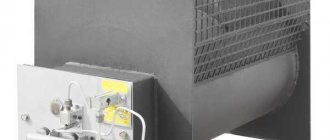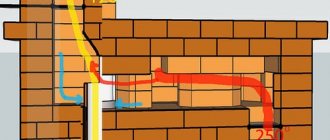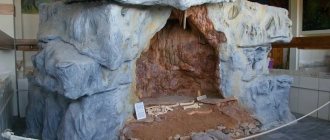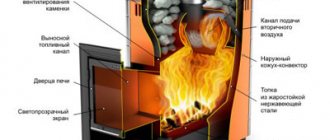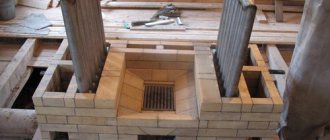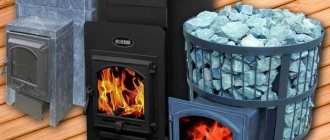One of the problems that will need to be solved in the process of planning a sauna is related to the correct choice of heating scheme for the sauna. The heater built into the steam room can provide only a third of the heat needs in the bathhouse, and even then most of it will be spent on boiling water and washing, so without additional heat sources, heating a bathhouse in winter can turn into a serious problem.
Possible bath heating options
With the advent of modern sauna stoves, the problem of heating a room has turned from a purely technical problem into an economic problem. Owners of modern saunas and steam rooms, when choosing how to heat their baths, are forced to balance between efficiency and comfort.
The bath heating system is selected based on its design and available energy sources. Today there are four main methods of heating a room:
- Heating of the bathhouse from a sauna stove. Depending on the size, the interior space can be heated with boilers and stoves using wood or gas fuel;
- Use of additional electric convectors, installation of electric water boilers complete with radiators or underfloor heating system;
- Equipment in the utility room of the bathhouse for an additional heating stove using wood, liquid or solid fuel;
- Connecting the bathhouse to a heating plant or to the heating system of private housing construction.
It is clear that the choice of a suitable scheme is always made with the expectation of providing the required level of heating for the bathhouse in winter. And it’s not even a matter of low temperature in the waiting room or locker room; the level of heating is directly related to air humidity and condensation.
For your information! The approximate level of heat load in maximum cold weather should be at least 1000 W/h per m2 of steam room and 600 W/h per square meter of the dressing room and dressing room.
Most often, problems arise in wooden log buildings heated by the heat of the brickwork of the heater. Therefore, before heating a log bath, you need to think about the ventilation system in the steam room and washing department.
What equipment is required for this?
In general, to ensure heating of the bath in winter, you can use a variety of equipment. Some users prefer water heating. Radiators or water heated floors can be connected to a heating plant or a heating system from the house. However, there is a certain disadvantage here. If you do not live in a country house permanently, the water in the pipes will simply freeze, bursting them, since the heating plant may stop working for several days for some reason. As a result, you will have to spend a lot of money and time to eliminate the consequences of such a breakdown.
Stove in a bathhouse with a water heater
Many people prefer electric heating devices. Their main advantage is ease of use. There is no need to spend money on installation or disassemble a ready-made bathhouse. You can bring one or two electric heaters into the dressing room at any time and turn them on half an hour to an hour before the start of the gatherings.
But there is a certain disadvantage here too. Most often, the humidity in the dressing room is quite high, especially if it is located across the wall from the steam room, and the door regularly opens and closes. Electrical appliances do not work well in conditions of high humidity - there is a high probability of breakdown. And being left without a heater before meeting friends on cold winter days is not a very pleasant surprise.
Electric heater for a bath
Therefore, electric heated floors remain one of the best solutions. Yes, you will have to spend a fairly large sum during installation - such work should only be performed by specialists if you do not have the appropriate skills. But in this case, you don’t have to worry about breakdowns or any other unpleasant consequences.
Electrical cables are reliably protected from moisture, which means they will not suffer even when working in difficult conditions. They are also not afraid of temperature changes. Even if you leave the dacha for several weeks or months, it is enough to turn off the heated floors - nothing will harm them. But when you get ready to go to the bathhouse, 3-4 hours before the water procedures it is enough to turn on the heating system. During this time, the temperature in the dressing room will rise to a level at which you and your guests will feel comfortable even after a hot steam room.
Heated floor diagram
The possibilities of electric heated floors are not limited to this. Some bathhouse owners decide to install a heating system, both in the bathhouse itself and outside it. First of all, this is the porch. Many bathhouse connoisseurs are familiar with the problem of porch icing. Water may be accidentally spilled there if you carry it to the bathhouse by hand.
But this can be avoided if, when installing a heated floor system, you order two circuits: one, large, for heating the dressing room, and the second, small, for heating the porch. In this case, the water will never freeze on the porch, but will drain from it or gradually evaporate. Be that as it may, the ice problem will be solved.
Heating in the bathhouse using the main stove
Just a couple of decades ago, ensuring a comfortable thermal regime in a bathhouse was ensured by the accumulated heat of the brickwork on the back side of the stove. The loading tunnel of the combustion chamber led into the dressing room, and the stove itself was built into the partition in such a way that the rear brickwork was divided in equal parts between the rest room, the locker room and the washing compartment.
In modern baths, brick stoves are built of much more modest sizes, so more efficient, cheap designs are widely used for heating the room:
- Water heating from a gas or wood-burning sauna boiler;
- Built-in heating from a heat exchanger or tank installed on the main stove of the bathhouse;
- Boiler heating using a heat accumulator connected to a sauna stove.
In addition, baths made of adobe blocks, adobe and adobe often use heating using hot air flowing through the stove registers through clay channels in the walls and subfloor of the room. The method is incredibly reliable and easy to use, but requires highly qualified craftsmen. Used primarily in dry continental climates.
Heating a sauna with a fireplace
Using a fireplace stove is considered one of the most effective ways to heat a small bathhouse in a country house or guest house. In this case, the sauna stove consists of two parts:
- A brick stove-heater with a combustion chamber, which is loaded with firewood from the steam room;
- A fireplace facade attached to the heater and overlooking the locker room or dressing room.
The fireplace and heater are combined into one brick structure; moreover, their chimneys are connected in one chimney. The large weight of a brick stove does not affect the quality of heating in any way.
Important! The fireplace should be heated first, and only after the chimney has warmed up can a fire be lit in the firebox of the heater. Otherwise, the fumes from the fireplace will burn out in the steam room of the bathhouse.
Organization of a water circuit using a stove-boiler
The simplest heating option involves the use of a special boiler model with a built-in water circulation circuit. To organize heating it is enough:
- Install and connect the expansion tank, pipes and pump to the water circuit;
- Hang aluminum radiators in the dressing room and washing area.
It is clear that before heating the bathhouse using a stove, you will need to perform a simple calculation of heat transfer in each room. If the boiler is gas, then set a comfortable air temperature in the locker room or washing department. Automatic combustion is capable of maintaining the temperature in the water circuit with an accuracy of one degree.
For your information! The main advantage of boilers with a built-in additional water jacket circuit is the unlimited amount of hot water that can be obtained for the needs of a home, cottage or summer kitchen.
It’s another matter if the stove-boiler with a water circuit runs on wood or pellets. In this case, even installing an additional tank does not help; in order to adjust the operation of water heating, you have to use a pump with variable water supply or install bimetallic thermostats on the radiators.
Heating by stove-stove
For small baths, a traditional heater remains a viable heating option. In this case, it is enough to purchase or manufacture a heating unit of the required power.
Calculation of equipment power is determined by the formula: 1 kW of power per 1 sq. m of premises. To ensure a comfortable stay for visitors in the steam room, a thermal power reserve of 35 to 55% is additionally taken into account.
The popularity of the heating heater is explained by the following advantages:
- ease of installation and maintenance;
- accessibility of operation;
- using available fuel.
When giving preference to a sauna stove, do not forget about some of the disadvantages of the device:
- impressive dimensions and weight;
- inability to automate the process of heating rooms;
- high fire hazard;
- formation of fuel combustion products.
Modern heaters operate on wood, electricity, liquid and gaseous fuel. The choice of the appropriate option depends on the financial capabilities and technical capabilities of the equipment.
To ensure effective heating of the room, heating the bath from the stove in the steam room is done as follows: the firebox is placed in the dressing room, the heater is in the steam room, and the tank with warm water is in the washing compartment.
Scheme of heating a room from a stove
A water sauna boiler is quite expensive, but the built-in heating circuit does not particularly affect the operation of the steam room, and is used in the sauna mainly in the cold season. From this point of view, the purchase and installation of a heating system for a bathhouse looks economically unjustified, especially in a situation where the bathhouse has only a steam room and a dressing room.
In addition to the boiler method of heating water, the steam room most often has a second source of boiling water - a mounted or hanging tank in which the liquid is heated to spray the heater backfill. Typically, 50 to 100 liters of water are boiled in such a tank. Is it possible to heat a bathhouse from a tank?
A simple calculation shows that in a tank with a capacity of 100 liters, filled to the top with boiling water, the heat stored is the equivalent of 8-10 MJ or 2.5-3 kW/h. If you use at least 80% of the energy, then this will be enough to organize heating of the dressing room from a sauna stove.
The sauna heating system can be improved almost twice if, instead of a built-in heating tank, you use a system with a heat exchanger built into the stove. You can extract heat from the stove in a variety of ways:
- Install a system of tubular registers made of steel pipes in a brick stove;
- Install a coil made of copper or alloy steel into the firebox;
- Use a structure made of double tanks as the walls of the combustion chamber.
To ensure efficient heating of the bath, the size of the furnace combustion chamber will need to be selected based on increased productivity. Typically, a firebox for a stove with a water circuit is selected for a single load of at least 2.5 kg of firewood.
Gas heating
The implementation of such a heating system has several options.
- Firstly, as I wrote above, it is possible to install a “classic” heater, in which a gas burner will be used instead of firewood.
- Secondly, you can use a standard gas boiler (the same as in residential buildings). But in this case, you will have to take care of the equipment of heating systems (installation of heating radiators, laying pipes, connecting a gas-carrying pipe to the bathhouse or a cylinder connection system).
- Thirdly, there is the possibility of installing heating from the house. In essence, this is the same option as the previous one, but with its own characteristics and disadvantages. A separate heating main is laid from the boiler used to heat the house to the bathhouse. This option is very convenient if your steam room is adjacent to the house or is very close to it.
Gas heating baths
If the distance to the bathhouse is relatively large, then in order to use this system in winter it is necessary to bury the heating main below the freezing level of the soil and insulate it well. This will prevent the possibility of defrosting and help reduce heat loss.
True, the undoubted advantage of this option is the complete elimination of the problem of maintaining a constant positive temperature in the bathhouse. In addition, you can do all the necessary work (if you have a certain skill) with your own hands.
Water heating is rightfully considered one of the most convenient and effective methods of heating. In such a situation, there are also several options for manufacturing a system, which in any case will be powered from a furnace with a water circuit.
Fortunately, today in specialized stores you can easily select stoves that are ready for installation, equipped with a heat exchanger. This greatly simplifies the task of any builder of his own bathhouse. And now directly about the options.
Water heated floors
- External heating. It is done very simply and, in fact, is arranged in the same way as a brownie. Pipes located along the walls are connected to the furnace. Depending on the area of your bathhouse, a certain number of heating radiators are connected to the pipes. Hot water passing through them heats the structure and, when cooled, returns back to the boiler.
- Water heated floor. The principle of its operation is the same as in the first option. The only difference is that the pipes are hidden in the floor, which was previously insulated (I wrote about insulating floors in a bathhouse in more detail in other articles). This design is considered non-separable (although, of course, there would be a desire to break everything), and therefore requires a very careful approach to the procedure for its manufacture. In this case, I would recommend seeking help from specialists.
Electric bath heating
The use of electricity to heat bath apartments is considered to be the most unprofitable heating method. Despite the fact that the technical part of the issue - the purchase and installation of two or three heaters costs mere pennies, the energy consumption for heating the dressing room and rest room using electric convectors is quite expensive.
Heating a bathhouse using infrared emitters is considered even more unprofitable and unsafe. According to reviews from the owners, such a device can be hung in the sauna vestibule above the front door; using it to heat the entire room is not economically profitable.
The only economically viable way to heat a room with electricity is to use an electrode electric boiler with aluminum radiators or heated floor equipment in the room. In this case, the cost of paying for consumed electricity is comparable to gas heating.
Heating system with heated floors
Modern underfloor heating systems are represented by electric and water heated floors. Water floors are an economical and affordable way to heat rooms, requiring high-quality installation, since repairing such a system is quite difficult.
To heat a rest room, dressing room or washing room, it is enough to install heated floors. All work can be done with your own hands. To do this, it is necessary to select pipes of a suitable diameter, calculate the operating resistance of the heating circuit and the required pump power, taking into account the area of the room.
Warm floors can be combined with radiator, electric and air heating.
Heating with heat accumulator
A relatively new method of heating living rooms in private homes using heat accumulators is also gaining popularity for heating baths. Moreover, a huge tank with an alkali solution or molten paraffin is most often installed either in the basement of a building or in a nearby outbuilding. A bathhouse is best suited for these purposes.
The heat accumulator is heated either by excess heat in the furnace or solar collector, or by electric heating at night. In this case, thanks to the reduced electricity tariff, heating costs are reduced several times, especially. if the bathhouse is located next to the house. An even higher level of savings can be obtained if you solve the problem of how to install heating into a bathhouse from home.
Heating from external heat sources
In this case, we are not talking about thermal heating pumps, although devices that can provide heating for several buildings on the territory of one household are already being actively sold in Europe.
Experts recommend not looking for futuristic, obviously time-consuming and expensive methods of heating bathhouses, but simply choosing the appropriate option for heating the bathhouse from home.
The economic part of the solution to the problem is obvious:
- There is no need to buy expensive gas or electric boilers. Laying communications from the heating boiler in the house to the collector in the bathhouse will cost an order of magnitude less;
- There are no grounds for possible claims from Energonadzor, fire and gas services;
- The larger the heating boiler, the higher its efficiency, so the kilocalories of heat obtained from a home heating system will be cheaper than the energy obtained by burning gas in a low-power sauna appliance.
The only significant problem is the correct choice of insertion scheme into the heating circuit of the house. Typically, water heating in a private house is built in the form of a closed ring with convective or pump supply of coolant.
If you try to simply cut a pipe into the “hot” part of the manifold of a heating boiler at home, then due to different hydraulic resistance in the pipes, a “stagnant” zone may form in one of the lines. Simply put, all the heat will either flow mostly into the bathhouse or remain in the heating system of the house.
To ensure that stagnation and the complex balancing procedure using throttling washers are avoided, when connecting a bath, an additional boiler with a heat exchanger built inside is used. The reservoir is included in the heating system of the house, the internal circuit is connected to the heating pipes of the bathhouse. The hot water accumulated in the boiler will be used as a thermal buffer, which will prevent the pipes of the main system from cooling down in the winter.



